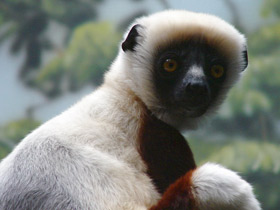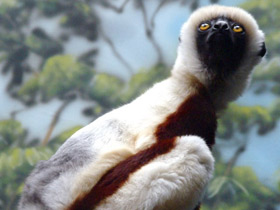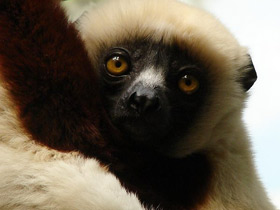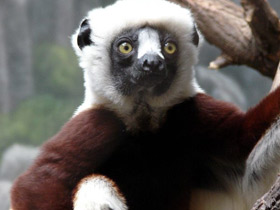The sifakas (Propithecus)
A sifaka (/sɪˈfɑːkə/; Malagasy pronunciation: [ˈsifakə̥]) is a lemur of the genus Propithecus from the family Indriidae within the order Primates. The name of their family is an onomatopoeia of their characteristic "shi-fak" alarm call. Like all lemurs, they are found only on the island of Madagascar. All species of sifakas are threatened, ranging from endangered to critically endangered.
Classification
- Family Indriidae:
- Genus Indri;
- Genus Avahi;
- Genus Propithecus:
- Propithecus diadema group;
- Diademed sifaka, Propithecus diadema;
- Milne-Edwards's sifaka, Propithecus edwardsi;
- Silky sifaka, Propithecus candidus;
- Perrier's sifaka, Propithecus perrieri;
- Propithecus verreauxi group;
- Coquerel's sifaka, Propithecus coquereli;
- Verreaux's sifaka, Propithecus verreauxi;
- Von der Decken's sifaka, Propithecus deckenii;
- Crowned sifaka, Propithecus coronatus;
- Golden-crowned sifaka, Propithecus tattersalli.
Coquerel's sifaka (Propithecus coquereli)
 Coquerel's sifaka (Propithecus coquereli) is included in the IUCN Red List as a threatened species
Coquerel's sifaka (Propithecus coquereli) is included in the IUCN Red List as a threatened species
Habitat and appearance
Coquerel's sifaka (Propithecus coquereli) is a diurnal, medium-sized lemur of the sifaka genus Propithecus.
Propithecus coquereli is common in north-western Madagascar, in the east its range is limited to the Bestiboca River. These beautiful lemurs inhabit tropical evergreen and dry deciduous forests. They are about the same size as a medium-sized dog, with a body length of 42-45 cm and a tail length of 55-60 cm and a weight of 3.5-4.3 kg.
The dense coat of Propithecus coquereli is predominantly white, with large, deep chocolate-brown patches on the chest and thighs of the forelegs and chestnut-coloured forelimbs. The ears of Propithecus coquereli are small and hairless, but conspicuous.
Sexual dimorphism in colouring is not characteristic of this species.
Like all Propithecus coquereli, it has a long tail which it uses as a balancer when jumping from one tree to another.
Nutrition and social behaviour
Propithecus coquereli feeds on bark, fruits, young leaves and dead wood during the rainy season and on mature leaves and shoots during the dry season. In total, the diet includes various parts of 98 plants. They spend up to 40% of their time foraging. Propithecus coquereli live in family groups of usually 4-5 animals. Like all primates, they express their affection for other family members by preening. They have teeth that protrude like a comb, which is extremely useful for combing their own and their conspecifics' fur. Each group covers an area of 4 to 8 ha, although Propithecus coquereli spends most of its time in a relatively small area of 2 to 3 ha. The territories of neighbouring groups often overlap, but aggression is rare: groups usually try not to confront each other.
Reproduction
The mating season for Propithecus coquereli is January-February. Pregnancy lasts 162 days and females give birth to a young in June-July each year. The young remain on their mother's chest for the first 4 weeks, after which the young lemurs move onto her back and travel on horseback until they are about 6 months old. Gradually the young become accustomed to the usual diet, tasting the portions given to them by the adult members of the herd. By December, when the calf is between 5 and 6 months old, it is fully independent. Young Propithecus coquereli reach sexual maturity at 2-3 years of age and live for 25-30 years. These rare primates are listed as endangered by the International Union for Conservation of Nature.
Economic importance
Coquerel's sifakas, like many lemurs, have been studied to help scientists learn about the evolutionary history of primates, including humans. They have been the subject of those researching evolution of color vision, paternal care, matriarchal primate societies, and causes of speciation.
Conservation status and threats
Though its populations are thought to be widely distributed, Coquerel's sifaka is found in only two protected areas in Madagascar - the Ankarafantsika National Park and the Bora Special Reserve. It is a critically endangered species, according to the IUCN's Red List of Threatened Species, and it is listed in CITES Appendix I. The principal threats to its existence are deforestation, habitat fragmentation, and hunting pressure. The local people often clear trees to produce new farming land, especially in the marshes where rice can be grown. In northwestern Madagascar, deforestation results from annual burning to create new pastureland for livestock. Trees are also cut for the production of charcoal.



















































